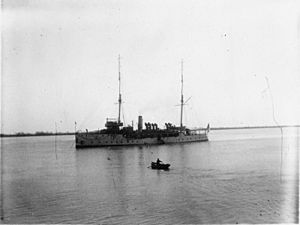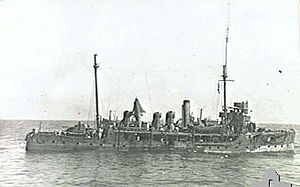HMS Thistle (1899) facts for kids

Thistle on the Yangtze in 1910
|
|
Quick facts for kids History |
|
|---|---|
| Name | HMS Thistle |
| Namesake | The Thistle |
| Builder | London & Glasgow |
| Laid down | 2 December 1897 |
| Launched | 22 July 1899 |
| Fate | Scrapped, 1926 |
| General characteristics | |
| Class and type | Bramble-class gunboat (1898) |
| Displacement | 710 long tons (721 t) |
| Length | 180 ft (54.9 m) |
| Beam | 33 ft (10.1 m) |
| Draught | 8 ft (2.4 m) |
| Installed power | 1,300 ihp (970 kW) |
| Propulsion |
|
| Speed | 13.5 knots (25.0 km/h; 15.5 mph) |
| Range |
|
| Complement | 85 |
| Armament |
|
HMS Thistle was a special kind of warship called a Bramble-class gunboat. It was built for the Royal Navy in 1899 and was taken apart in 1926. The Thistle was one of the last "classic" gunboats from the Victorian era. It was also the very last British warship that still used sails for power, not just for show!
Contents
Discovering HMS Thistle's Design
HMS Thistle was the last of four ships in the Bramble class. These ships were built in the 1890s. Their main job was to patrol far-off parts of the British Empire. This was a time when countries often used warships to show their power, a practice called "gunboat diplomacy."
The Thistle looked a lot like a smaller version of a modern warship. It was made of steel and had up-to-date weapons. The crew also had very comfortable living areas.
However, the Thistle had a special design. It had a shallow bottom, which meant it could sail in shallow waters and on rivers. This was important for exploring new coasts and tropical rivers. But this design also meant it couldn't carry much coal for its engines.
To save money and make repairs easier in distant places, some older technologies were used. For example, the Thistle had two masts with sails to help it move. It also had a manual capstan (a machine to pull up the anchor) and used candles instead of light bulbs.
Soon after the Thistle was launched, the Royal Navy decided not to build any more gunboats. They also stopped encouraging the use of sails on warships. But the Thistle often had problems with its engines on long trips. Because of this, its sailing rig was put back on in 1919. The ship was also updated in the 1920s with new weapons, including anti-aircraft guns, to keep it useful in different parts of the world.
Adventures of HMS Thistle: A Ship's Journey
The Thistle was built at the London & Glasgow shipyards in Govan. Work began in December 1897. It was the last ship of its class to be launched, which happened on June 22, 1899. The ship was fully ready for service by 1901. During its sea tests, it performed very well, reaching its planned speed of 13.5 knots (about 25 kilometers per hour) using its engines.
Exploring the North Atlantic and West Africa (1902-1905)
HMS Thistle first went to the North America and West Indies Station. This was a naval base for British ships. Its first commander was Lieutenant Edward Stafford Houseman. In the spring of 1902, the ship sailed around the North Atlantic Ocean. It visited places like São Vicente, Cape Verde, Barbados, Bermuda, and New York.
After arriving in Halifax, Nova Scotia, in May, the Thistle was prepared for protecting fishing areas around Newfoundland. Later that year, it visited the Azores, Sierra Leone, and Gabon River. In October 1902, it arrived at Saint Helena.
In June 1904, the Thistle was in West Africa. Its crew played the first organized games of cricket and football in Nigeria. They lost both games to local teams from the Hope Waddell Training Institution. In 1905, the Thistle was at Simon's Bay. There, it saw Admiral Rozhestvensky's Russian fleet arrive. This fleet was on a very long journey from the Baltic Sea to the Battle of Tsushima. People were worried because only the Thistle and another ship, HMS Crescent, were there to face such a large fleet of battleships.
Serving in the Far East (1906-1914)
After its time in Africa, the Thistle moved to the China Station. Its job was to protect British interests in the "treaty ports" along the Yangtze river. It was stationed 600 miles (about 965 kilometers) inland at Hankou (which is now part of Wuhan).
The first few years there were quite peaceful. The ship's surgeon, Walter Perceval Yetts, became very interested in Chinese culture. He later became an important expert on China, known as a sinologist.
In 1911, the Thistle was involved in a big crisis that led to the Chinese Revolution. After this, it was sent back to Hong Kong. The ship spent more and more time in the harbor. It only made occasional trips across the South China Sea to coastal towns in mainland China. By now, it relied only on its engines.
When the Great War started, the Thistle and other gunboats in China were taken out of service. Their crews were needed to staff an older battleship, HMS Triumph, which was considered more important for the war.
Supporting Efforts in East Africa (1915-1918)
In 1915, the Royal Navy decided to bring HMS Thistle back into service. They planned to send it to East Africa. The original idea was for it to go into the Rufiji Delta to fight a German cruiser, SMS Königsberg. However, the Navy changed its plans. They sent two powerful ships called monitors, HMS Mersey and HMS Severn, through the Suez Canal. These monitors then destroyed the Königsberg before the Thistle even left.
Even so, the Thistle was recommissioned with a new captain, Lieutenant-Commander Hector Boyes. It began its long journey from Hong Kong to Zanzibar. At first, the ship had many engine problems, especially on the way to the Straits of Malacca. For much of this part of the trip, other ships had to tow the Thistle.
The engines worked better on the long voyages across the Indian Ocean, from Singapore to Colombo and from the Maldives to the Seychelles. But on both these parts of the journey, the ship nearly ran out of coal before reaching its destination. HMS Thistle finally arrived in East Africa in November 1915. It stayed there for the rest of World War I.
In September 1916, the Thistle took part in a campaign against German East Africa. This involved landing troops from the sea. The Thistle provided fire support from the coast. It even pushed through difficult waterways to help soldiers fighting inland. The more powerful monitors, Mersey and Severn, were also there. But the Thistle still did very well, especially in defending Lindi from German artillery. For this action, Commander Boyes received the Order of St Michael and St George. Leading Stoker James Leach received the Conspicuous Gallantry Medal.
The most important moment for the gunboat in East Africa happened later. By July 1918, German troops had entered Portuguese Mozambique. They had defeated the British and Portuguese forces there. The Thistle was anchored in the harbor at Quelimane. It seemed to be the last defense against a major German victory.
The port was supposedly protected by a Portuguese cruiser, Adamastor. But the governor, Colonel Tómas de Sousa Rosas, wanted to use his ship to escape with his belongings. He planned to abandon the harbor and its supplies to the Germans. Commander Boyes decided to stay and fight with the Thistle and its small crew. This brave act shamed Sousa Rosas and the Adamastor into staying too. This stopped the Germans from attacking. For his determination, Commander Boyes was awarded the Portuguese Order of Aviz.
Returning to West Africa (1919-1924)
In 1919, HMS Thistle was ordered to return to West Africa. But almost as soon as the ship left Zanzibar, one of its propellers broke. The gunboat's new captain, Lieutenant-Commander Cecil Cruttwell, had learned to sail on a square-rigged training ship called HMS Conway. He quickly had the crew make a new set of sails.
The new sails were always used with the engines, helping the ship go faster and use less fuel. They were so useful that they were kept even after the engine was fixed. The limited coal supply continued to be a problem. During a visit to Liberia in 1920, the crew had to get wood in Monrovia to avoid running out of fuel completely. HMS Thistle kept its sailing rig for the rest of its time in service.
By 1919, the Thistle no longer had its main topmast. The mainmast was changed to become the mizzen mast. The ship then had a ketch sailplan. This meant it had a jib sail at the front, a tall square-rigged foremast with a mainsail and topsail, and two fore-and-aft sails on the shorter mizzen mast (a staysail and a trysail spanker). Later, it used an even simpler rig with just three sails: its jib, one square sail on the foremast, and a single fore-and-aft sail on the mizzen.
Even though the sails were used with the engines, the Thistle was special because it went back to using sails for propulsion. Other Royal Navy warships used staysails to help them stay steady in rough seas or hold their position. This practice continued until HMS Reclaim was taken out of service in 1979.
The Thistle stayed on the Atlantic coast of Africa. It was updated and given new weapons. It lost its smaller guns and machine guns, getting anti-aircraft cannons instead. It was still performing "gunboat diplomacy" in early 1925. A few months later, HMS Thistle sailed home for the last time. Newspapers around the world reported on the end of the age of sail for this ship.
The old hull of the Thistle was then sold to be taken apart for scrap metal in August 1926.
Online Sources
- "Britain's Last Sailing Warship to Be Scrapped", Milwaukee Sentinel, 17 May 1925 1
- Logs of HMS Thistle, 1914-1924 (Naval-History.Net): 1, 2, 3.
- Details at the Clydebuilt Ships Database: [1]
- Photographs taken by Lt. Douglas Claris of HMS Thistle, 1910-1912 (Imperial War Museum): p1, p2, p3.
- Summary of Cmdr. Boyes' command of Thistle in 1915-1918 and the medals awarded: [2].
- Leading Stoker Leach's gallantry award: [3]


